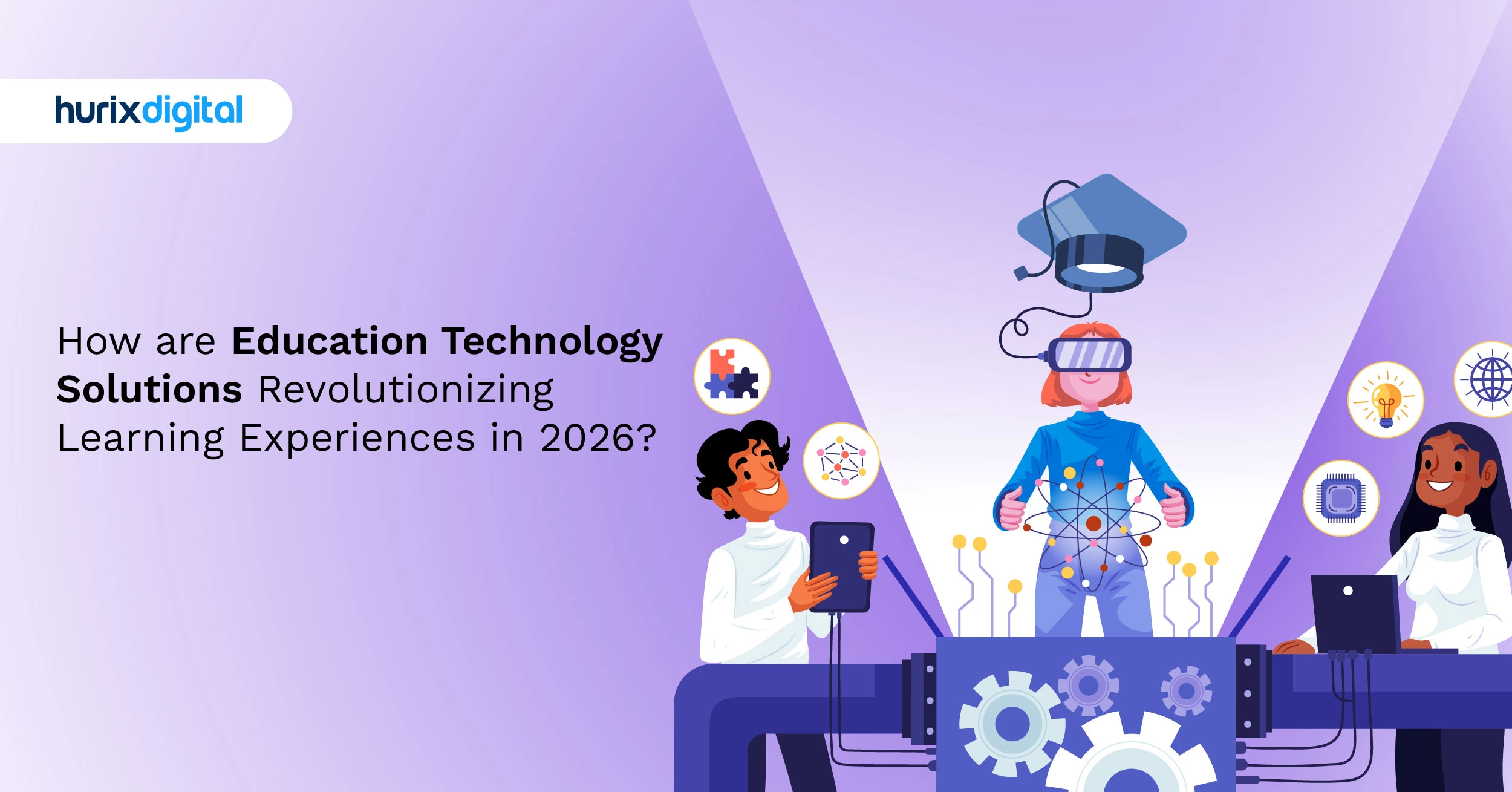
How to Create and Deliver the Best K12 Learning Solutions?
Summarize with:
K12 learning solutions have evolved from mere conveniences into transformative educational tools that significantly enhance the learning experience. The global K12 education market, valued at $103.5 billion in 2021, is projected to reach an impressive $525.7 billion by 2031.
This rapid growth reflects the increasing integration of cutting-edge technology, which enables personalized and interactive learning experiences. Such advancements not only improve student engagement but also enhance overall educational outcomes.
Modern K12 learning solutions effectively bridge the gap between traditional teaching methods and the digital revolution, preparing students for success in an increasingly tech-driven world.
Table of Contents:
- What is the K12 Learning Solution?
- Benefits of K12 Online Learning Solutions
- How to Develop Effective K12 Learning Solutions?
- Content Development
- Create Engaging Content
- Leverage Multi-Media for Maximum Benefit
- Create Interactive Content
- Leverage External Communities and Social Media
- Use Assessment Tools
- Create Device-Independent Content
- Hyperlink Your Content
- Integrate Emerging Technologies
- Create a Digital Content Library
- Use a Mobile-First Content Delivery Platform for Effective Distribution of K12 Content
- Incorporate Feedback Mechanisms
- Facilitate Teacher Training and Support
- Promote Parental Involvement
- To Wrap Up
What is the K12 Learning Solution?
K12 learning solutions refer to educational content from kindergarten to grade 12. The content is used to teach primary, middle, and high school children. In the age of the digital, K12 learning solutions usually consist of online learning material that is widely used to supplement classroom teaching.
Creating effective K12 solutions goes beyond traditional teaching methods. It involves designing a comprehensive framework that leverages technology, engages students, and meets diverse learning needs. By doing so, educational institutions can create dynamic environments that enhance both teaching and learning experiences.
Also Read: 5 AI-Powered Educational Games Your K5 Students Will Love
Benefits of K12 Online Learning Solutions
There are several benefits of K12 online learning solutions.
- First, text reading is supplemented by audio and video materials, which make lessons more interesting and spark interest in young minds.
- Second, these modules can be in the form of games with levels and challenges but with some embedded learning goals. Children love games so it is a great way to hook them to a subject, ignite their interest, and prompt them onward on the learning journey through challenges and rewards.
- Third, the K12 learning solutions are also beneficial to the instructors, such that they are spared the task of preparing their own teaching aids. The time thus saved can be more constructively invested in giving more individual attention to the students. Besides, these solutions also empower educators with tools for online assessment, reporting, and collaborative learning.
How to Develop Effective K12 Learning Solutions?
Creating K12 learning solutions includes building engaging, interactive, and accessible content with digital media and technology for diverse student learning. So, let’s dig into the fundamentals of how to develop effective content.
1. Content Development
If you don’t have in-house experts, you can outsource your content development to an eLearning development company with the right knowledge, skills, and experience in creating K12 learning solutions. Hurix Digital, for instance, offers tailored digital content and interactive solutions to enhance learning outcomes effectively. Their expertise in leveraging technology ensures that educational institutions receive innovative and scalable solutions.
It is important to keep the following points in mind while developing content for K12 learning solutions.
2. Create Engaging Content
Online content is different from offline content. In digital content, elements like audio and video accompany print text, which means that students can see, hear, and read the lesson. This leads to better understanding and retention.
So, while creating content for K12 learning solutions, it is recommended to make the best use of digital media elements to make content more engaging to the learners. Consider incorporating adaptive learning content that evolves with student performance, helping educators identify areas where students excel or struggle. Also, create multi-language resources to accommodate diverse student backgrounds and ensure accessibility for all learners.
3. Leverage Multi-Media for Maximum Benefit
As mentioned above, one of the main differences between textbooks and online K12 learning solutions is the fact that you can deploy digital media to maximum advantage.
For example, simulations and 3D models can be used to give concrete shape to abstract concepts. Similarly, virtual reality can be used to transport students to the various continents and countries being taught in a geography lesson. Or you can use gamification to motivate and challenge students to solve complex problems.
4. Create Interactive Content
You can create interactive content or interactive ebooks so that students can gain hands-on practice and experience. Interactive content is in the form of activities, which can be a solo or group-based task. Solo activities allow students to do and learn at their own pace. In the case of group activities, students are divided into teams, which are then pitted against each other.
The important thing to keep in mind while designing such activities is that they should not be overly aggressive to promote competition. Rather, they should help inculcate into students the values of collaboration, teamwork, empathy, etc.
5. Leverage External Communities and Social Media
While developing content for K12 learning solutions, be sure to embed social media elements and links to external communities to keep the conversations on the subject going. This will keep the interest in the subject alive, stimulate interesting debates, open up new avenues of thought and promote independent thinking.
Consider creating dedicated online forums or learning communities where students can interact, collaborate, and share knowledge outside of class hours. This approach encourages peer learning, supports collaboration, and fosters critical thinking among students.
6. Use Assessment Tools
You can add custom grading scales and also assign controls to release marks and feedback to individual learners. Instead of formal tests, you can assess students based on quizzes and other such activities. While students dread class tests, they enjoy the quizzes and challenges in online assessments.
Besides, they can also revisit the concepts when they encounter roadblocks. Online reporting tools generate activity and participation reports, and analytic tools can be used for data analysis of students’ performance.
7. Create Device-Independent Content
These days, people generally consume their content on mobile devices, while on the move. While creating K12 learning solutions, create content that can be comfortably viewed on all device types, be it a mobile phone, tablet, or laptop. This will give students the flexibility to fit their learning into their free moments.
8. Hyperlink Your Content
You can hyperlink the lessons to internal and external resources. Students can use these links to gain additional information about the subject and better understand the lesson. Besides, you can also use augmented reality to bring alive a concept, for example, a 3D model of a functioning heart.
Most students have smartphones and all they have to do is download an AR app and point it at the content and the model will show up. All such features make learning easy, interesting, immersive, and relevant.
9. Integrate Emerging Technologies
New technologies are changing the landscape of K12 learning solutions. Use AI-driven personalization to provide each student with a personalized learning experience focused on their progress and real-time support. This ensures students receive targeted help and challenges, enhancing their learning journey.
Similarly, use Augmented Reality (AR) to visualize complex scientific processes or bring historical events to life. For example, students can explore 3D models of the human body or ancient civilizations, making subjects more tangible and interactive.
10. Create a Digital Content Library
While developing K12 learning solutions, you can also include a content library. Publishers can either create one themselves or choose a vendor that has a K12 content library which includes a vast repository of engaging and interactive video-based learning content. As mentioned above, the learning content can be hyperlinked to external and internal resources.
Students can be redirected to the content library to access more information on the topic. Or they can be given complete access to the library to search for additional learning resources whenever they want.
11. Use a Mobile-First Content Delivery Platform for Effective Distribution of K12 Content
A mobile-first content delivery platform is the perfect tool to deliver K12 learning content. It allows you to design interactive, multimedia-rich, and device-independent digital content. Choose a platform that is hosted on the cloud or a cloud-based content delivery platform so that your students can access the content anytime and anywhere.
Besides, a content delivery platform also helps you securely publish and distribute your K12 learning solutions on all mobile operating systems, complete with analytics, assessments, and interactivities.
12. Incorporate Feedback Mechanisms
Integrating feedback mechanisms is essential for continuous improvement in K12 learning solutions. Encourage students to provide feedback on their learning experiences through surveys, polls, or discussion forums.
This information can help educators understand what works and what doesn’t, allowing for adjustments in content and delivery methods. Additionally, incorporating formative assessments and peer reviews can foster a culture of constructive feedback, promoting student engagement and self-reflection.
13. Facilitate Teacher Training and Support
The successful implementation of K12 learning solutions depends heavily on the educators who deliver them. Provide comprehensive training and ongoing support for teachers to help them navigate new technologies and instructional strategies.
This could include workshops, webinars, and resource materials that empower teachers to effectively use the learning solutions in their classrooms. Ensuring that educators feel confident and competent in using these tools will ultimately enhance student learning outcomes.
14. Promote Parental Involvement
Engaging parents in the learning process can significantly impact student success. Develop resources and strategies that encourage parental involvement, such as newsletters, workshops, or online portals where parents can track their child’s progress and access learning materials.
Guiding how parents can support their children’s learning at home can create a more holistic educational experience and strengthen the connection between home and school.
Also Read: Customized Learning Experiences: Personalizing Education with Educational Video Games in K12
To Wrap Up
Modern K12 learning solutions are a major leap forward in education. Innovative technologies such as AI, AR, and adaptive learning platforms provide the potential for educators to create engaging, accessible, personalized learning that meets diverse students’ needs.
While schools and institutions are still navigating the changing educational landscape, they must continue to investigate and adopt these latest educational solutions to reimagine what traditional learning looks like for students by making it more immersive and impactful in their quest to excel in the ever-evolving world.
Hurix Digital, on this note, can help you create innovative solutions that inspire and engage students. Our expertise in developing tailored K12 learning solutions ensures that educators can effectively leverage the latest innovations to create immersive, impactful experiences that resonate with students. Reach out to us for further details.
 A Space for Thoughtful
A Space for Thoughtful 


